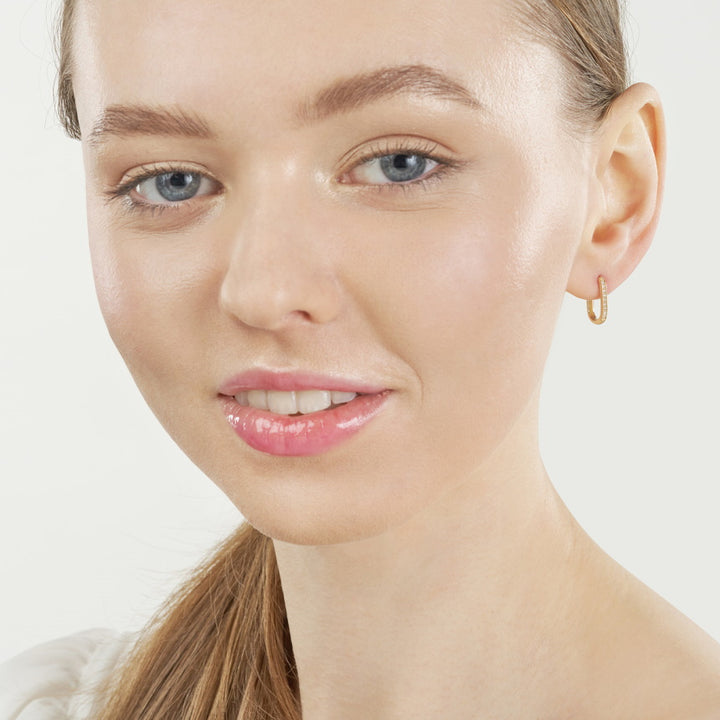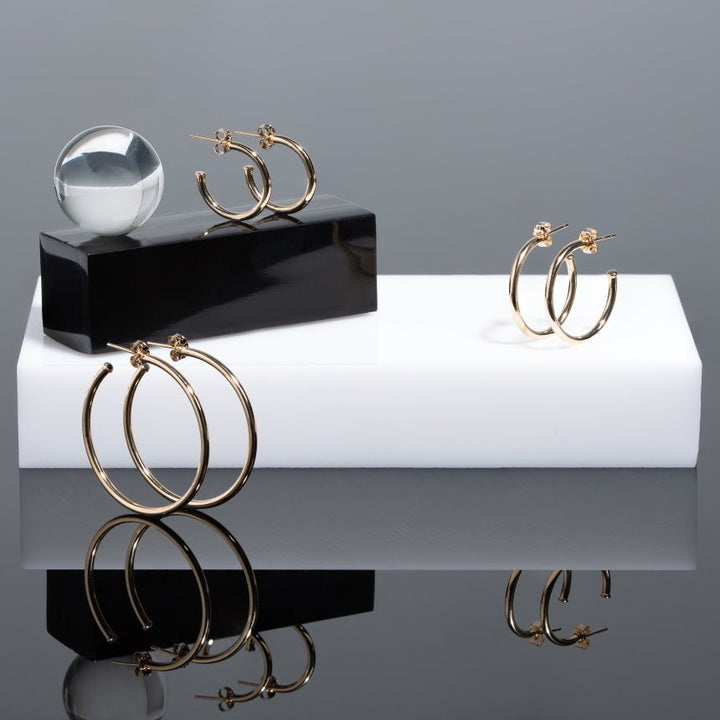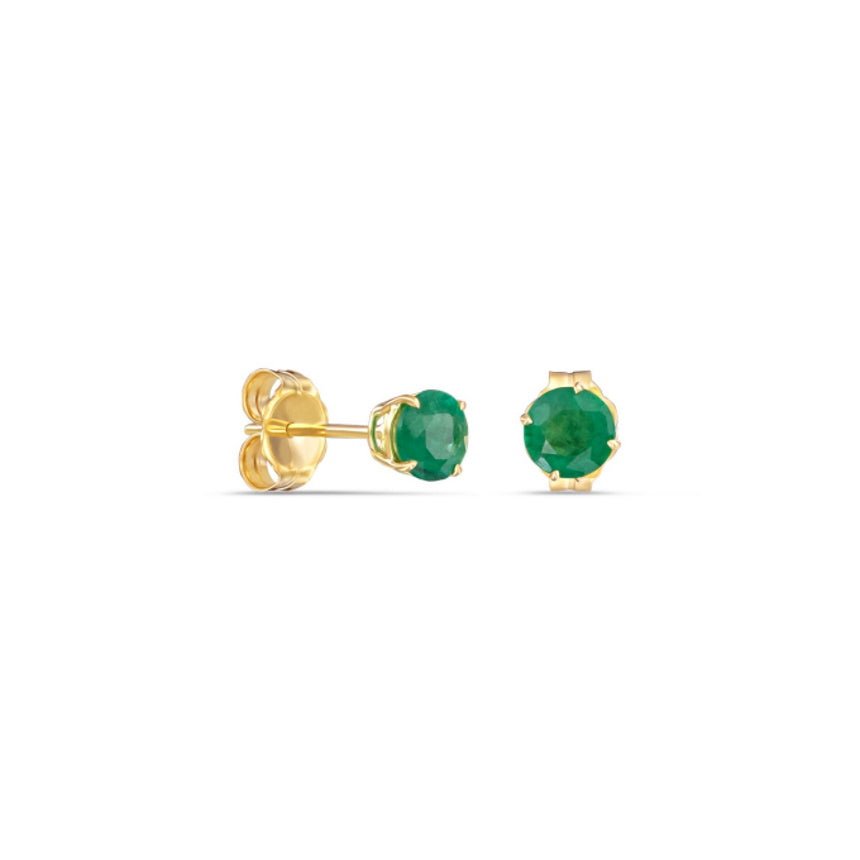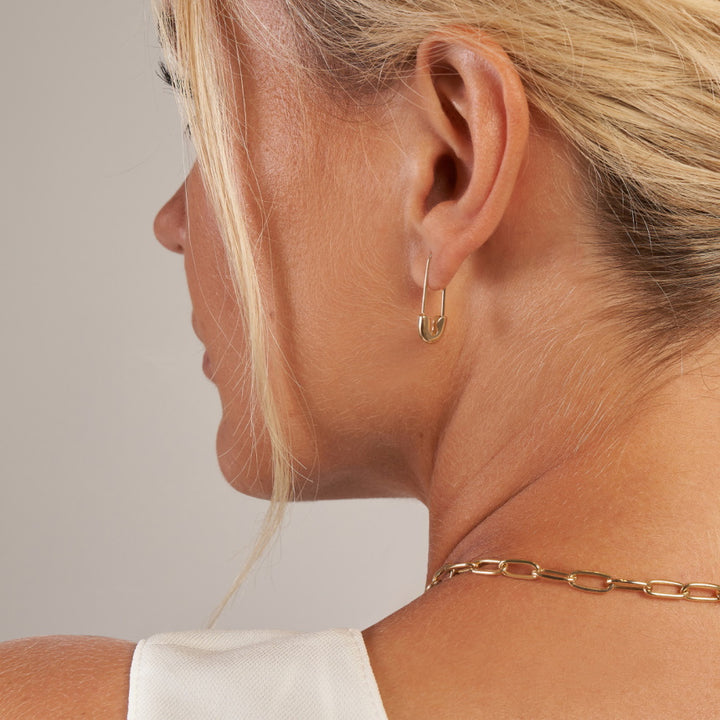
What Earrings Are Hypoallergenic?
Are you itching to know What Earrings are Hypoallergenic? Unfortunately, many people experience allergic reactions to earrings including itchiness, redness, rash, dry patches, or skin swelling.
If you’re looking for allergy-free earrings, you will want to look for jewelry labeled as hypoallergenic. These pieces are specifically crafted with pure metals, significantly reducing the likelihood of any adverse skin responses. In general, the safest bet for those with sensitive ears is hypoallergenic gold. However, if you’re wanting to expand your jewelry options, know that you do have other choices!
Intrigued? Let us guide you through the details of hypoallergenic earrings and expose you to a world of possibilities where style and comfort coexist! Here’s what you should know about hypoallergenic earrings.
What Makes Earrings Hypoallergenic?

Our earlobes have some of the thinnest skin, like our eyelids, making them more prone to skin irritation. Hypoallergenic earrings are those that cause fewer allergic reactions. This can make them ideal for people with sensitive ears. However, hypoallergenic earrings don’t eliminate reactions, so there will still be a trial period to see if earrings labeled as “hypoallergenic” work for your ears and skin. Don’t assume that any pair of “hypoallergenic earrings” are safe for you or your child.
Hypoallergenic products aren’t regulated, and the manufacturer isn’t required to meet a set standard. For instance, the state of California has a Metal-Containing Jewelry Law. This law restricts the use of cadmium and leads in jewelry but not nickel, which can often cause allergic reactions.
In the EU, more specific restrictions police the nickel in jewelry, but jewelry sold in North America isn’t required to meet those standards. Keep this in mind when testing and trying jewelry, even hypoallergenic jewelry. A lot of it may come down to trusting the manufacturer that you purchase your jewelry from.
What Jewelry Is Hypoallergenic?

Before we get to which jewelry is the least likely to cause skin reactions, let’s talk about the metals most likely to cause sensitivity. Everyone has different body chemistry. As a result, some metals are more likely to cause a reaction than others.
Brass
Brass is an alloy (mix) of zinc and copper. Because it’s a lower-grade base metal, it often causes allergic reactions. If you discover you have a brass allergy, you should also avoid plated-brass jewelry.
Nickel
Nickel is the most common metal allergy. If you’re having trouble finding jewelry that works for you, then nickel could be the reason. Nickel is a naturally white metal often mixed with others to create an alloy. It’s inexpensive, so it’s found in many cheaper jewelry pieces.
Some gold jewelry contains nickel, so it is essential to ensure your 10k, 14k, and 18k gold isn’t mixed with nickel if you want to reduce allergens. To further elaborate, pure old is called 24k gold. Jewelers mix in other metals, such as zinc and brass, to make the gold more durable. 14k gold is 58.3% pure gold and 41.7% other metals.
Low Melting Temperature Metals
Zinc, tin, and lead are low metal temperature metals that are also used in lower-cost jewelry. They commonly have an adverse reaction to human skin. Copper can also cause issues. However, if you see a green skin discoloration after wearing copper jewelry, don’t worry. This isn’t a sign of an allergic reaction or sensitivity. This is typically caused by the metal reacting with moisture or sweat on the skin.
Is Gold Plated Jewelry Hypoallergenic?
Gold plating means taking a base metal, such as brass or sterling silver, and dipping it in gold. This means that there are two things to look for: the base metal hypoallergenic and the gold used in the nickel-free plating. Gold-plated sterling silver jewelry is more hypoallergenic than gold-plated brass jewelry because of the base metal. This is the same for gold vermeil and gold-filled jewelry.
Best Metal for Sensitive Ears

Okay, now that you know what NOT to wear if you’ve been experiencing sensitivity or allergic reactions, here are the best metals for sensitive ears. These are metals that are commonly used in hypoallergenic earrings.
Keep in mind that 100 percent gold and silver jewelry don’t exist because the metals are too soft to be worn by themselves. However, it does matter what your jeweler is mixing the metals with, as this is what causes allergies. More information can be found on this in our article: What Is the Difference Between 14k and 18k gold?
Sterling Silver Hypoallergenic

Sterling silver is 92.5% pure silver and 7.5% other alloys. The reactivity of sterling silver is very low when the alloy is copper or zinc. Double-check before purchasing that your sterling silver earrings are nickel-free.
Is Gold Hypoallergenic?

Gold is an ideal hypoallergic metal, primarily when you use gold with high karats. In the US, 10K gold (42 percent gold and 58 percent other metals) is the lowest purity that can be legally marketed as “gold.” Again, double-check before purchasing what the gold is mixed with to ensure it won’t cause reactivity.
Now, another common question: is gold-plated jewelry hypoallergenic? Gold plating is an option, but it’s not always the best. The base metal underneath the gold often contains nickel that can wear away with time and use and cause sensitivity or reactions.
Often white gold will contain nickel as part of the rhodium process. Compared to white gold and rose gold, yellow gold tends to have nickel added the least.
Stainless Steel Hypoallergenic
Stainless steel is widely considered a hypoallergenic metal. It’s an alloy that can contain chromium, steel, and nickel. However, it comes in different percentages of nickel content, so investigate what this content is before purchasing.
Titanium
Titanium is a stellar option for sensitive ears. They provide both comfort and style without causing your body any issues. Titanium is used in medical devices and implants, which means allergies are extraordinarily low.
Platinum
Platinum is considered a hypoallergenic metal because of its purity and non-reactive nature. If you have sensitive skin, this is an overall safe option.
Medical Grade Jewelry

If you have difficulty finding any jewelry that works, try medical-grade jewelry. It’s designed to protect your skin when you wear it all the time. The materials used in medical-grade jewelry are used in various medical implants and devices. If it’s safe to use inside your body, it’s okay to wear it externally.
Another medical-grade option is plastic. Some people aren’t crazy about wearing plastic earrings but won’t be sleek or elegant. This is often an excellent option for children because they won’t cause allergies while being durable.
Hypoallergenic Earrings FAQS
What do nickel-free earrings mean?

Nickel-free earrings are hypoallergenic earrings not synonymous. Hypoallergenic earrings are known to cause fewer allergenic reactions. However, these earrings may still contain trace amounts of nickel. For instance, there may not be any nickel on the surface of their posts, but it could exist under the coating, which could irritate your skin once the coating wears away.
Therefore, if you know you have a nickel allergy, you should look for nickel-free jewelry specifically. Here are some options that you may be interested in.
o Sterling silver stamped .925 — typically, this is 92.5 percent pure silver alloyed with other metals (usually copper, not nickel)
o Niobium — a hard metal like titanium but malleable and reflective of rainbow colors
o Pure medical-grade titanium — highly resistant to corrosion and containing no other metals
o Pure gold alloyed with silver and copper — does not contain nickel
§ Make sure you avoid white gold if you have a nickel allergy, as it often contains nickel for strength and color
Will hypoallergenic earrings turn green?

To understand whether hypoallergenic earrings will turn your ears green, you must understand why jewelry turns green in the first place. A reaction of the skin with copper is the cause of green skin.
The metals least likely to turn your skin green are platinum and rhodium. However, hypoallergenic earrings are less likely to tarnish and expose metal that’ll cause any reaction. So, you should be safe from green jewelry either way, especially if they don’t contain copper.
Do hypoallergenic earrings tarnish?

Because hypoallergenic earrings contain little to no alloys, depending on what you select, they will never corrode, tarnish, or rust over time. Other materials on the earring such as enamel can corrode.
Can you wear hypoallergenic earrings all the time?

You can try to wear hypoallergenic earrings all the time. However, if you have susceptible skin, repeated wear can still cause irritation especially because some hypoallergenic earrings are coated with one material. Once this coating wears off, then the material underneath may be what irritates your ears. If you’re worried about this happening, opt for earrings made with gold, platinum, or silver. It is always best to remove earrings when exercising and sleeping. If you have an allergic reaction, it is important to see a dermatologist to avoid infections.
Where to Buy Hypoallergenic Earrings?

The best place to buy hypoallergenic earrings is a jewelry provider using pure metals like gold, fine silver, sterling silver, platinum, titanium, and surgical stainless steel. These metals have a minimal risk of causing an allergic reaction on sensitive skin. As noted above, there is no regulation regarding hypoallergenic earrings. Manufacturers can use this label however they wish, so it’s important to find a company you trust when buying pairs of earrings that won’t cause skin reactions. When getting ear piercings, it is essential to put in hypoallergenic metals initially.
Alexis Jae skips the middleman and creates high-quality, ethically sourced custom pieces. We only sell fine jewelry (14k or 18k gold) with precious or semi-precious stones. Both our 14k gold and 18k gold doesn’t contain nickel.
We can replace a gold post with a titanium one for people with an allergy to gold. Whether you’re looking at pearl earrings, diamond studs, or chunky hoops, we can find a way to adjust the material to work for your skin allergies.
The Best Hypoallergenic Earrings
Second Hole Hoop Earrings

Second hole huggies are a great choice for people with sensitive ears because they are designed to fit snugly and comfortably against the earlobe without irritating or pulling on the skin.
Large Safety Pin Earrings

These solid gold safety pin design involves a larger surface area that comes into contact with the ear, reducing the pressure and weight distribution compared to smaller stud or hoop earrings. This can help prevent discomfort or irritation on sensitive earlobes.
Midnight Blue Drop Earrings
Who said hypoallergenic earrings couldn’t be colorful? Gemstones (for most people) are hypoallergenic. Drop earrings hang away from the earlobe, reducing the amount of pressure or pulling on the skin that can cause irritation.
Gold Ball Stud Earrings

The hollow design of these earrings makes them lightweight, reducing the pressure and strain on the earlobe. Additionally, the large size of the ball studs can help distribute weight more evenly, reducing the risk of discomfort or irritation.
Gold Ball and Chain Earrings
The design of these dangle earrings involves a small gold ball attached to a chain, which allows for movement and reduces pressure on the earlobe. The lightweight nature of the design also helps prevent discomfort or irritation.
In Conclusion
If you have any questions, please get in touch with us about Creating Your Own Jewelry. We’re always happy to customize pieces or craft something new according to your vision. The best part? You can save 50 percent off traditional retail prices! Visit here to learn more. If you want hypoallergenic jewelry, please reach out so we can customize it. For in-person appointments, we are based in New York.

0 comments